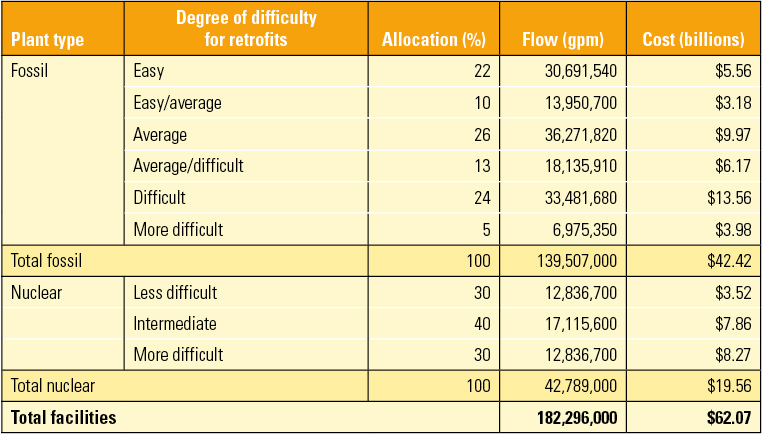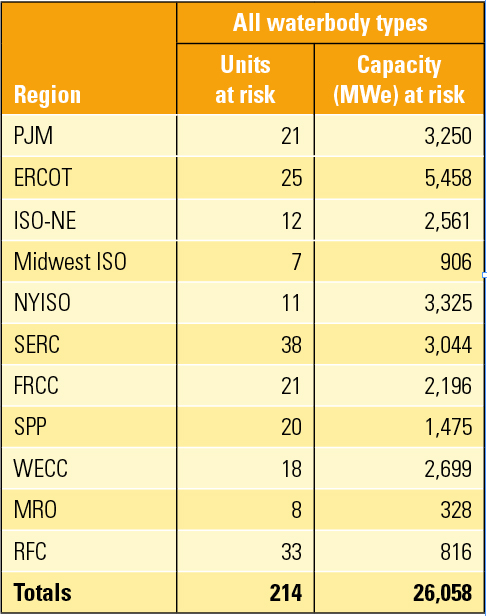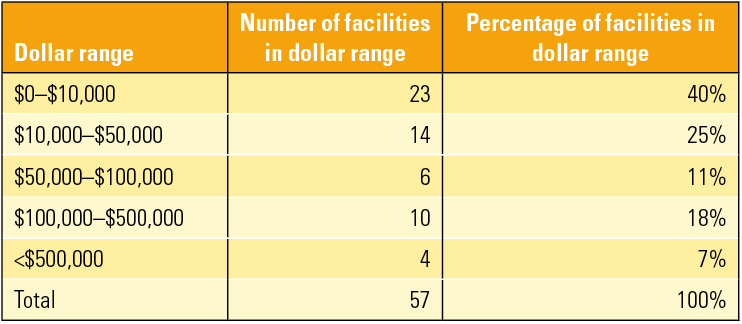Potential Impacts of Closed-Cycle Cooling Retrofits at U.S. Power Plants
Power plant owners face numerous challenges ensuring adequate water supplies for operations while protecting aquatic life in the water bodies that provide power plants with cooling water. In the U.S., Section 316(b) of the Clean Water Act requires plant owners to minimize the adverse impacts of impingement and entrainment mortality by potentially installing fish protection technologies on cooling water intake structures. The U.S. Environmental Protection Agency (EPA) is finalizing regulations under Section 316(b) that may require installation of cooling water intake fish protection technologies or potential retrofit of closed-cycle cooling systems (cooling towers).
On April 20, 2011, the EPA released a proposed rule implementing the requirements of Section 316(b) for existing facilities. In the proposed rule, the EPA noted that closed-cycle cooling systems were not a best technology available (BTA) for reducing adverse impacts of cooling water intake structures; however, entrainment standards developed on a site-specific basis could require retrofits of closed-cycle cooling systems. Furthermore, although the EPA rejected closed-cycle cooling as BTA and selected a regulatory option that provides for site-specific development of entrainment standards for protecting aquatic life, it did consider two options that included requirements for closed-cycle cooling, and one of these options could be adopted for the final rule, scheduled to be issued in June 2013.
EPRI recently completed a study of the estimated costs, benefits, impacts, and environmental consequences of a potential national requirement to retrofit cooling towers on all once-through facilities in the U.S. The estimated costs exceed $100 billion on a net present value basis.
Research Approach
A first key step in the research was to develop an accurate list of once-through facilities. EPRI’s initial draft list was developed with information from the EPA and the Department of Energy. EPRI then sent the draft list to the electric industry for review and verification. EPRI also contacted some facilities directly to seek clarification on plant- and unit-specific operational status.
A spreadsheet model was developed to estimate the cost to retrofit 125 facilities based on existing cost estimates and a worksheet completed by facility owners. These 125 estimates were then extrapolated to generate the national retrofit cost estimate for all nuclear and fossil generating stations. The study results provided input for an economic model used to estimate the number of units and megawatts at risk of premature retirement if they were required to retrofit closed-cycle systems. The model input parameters included unit-specific capacity utilization and hourly dispatch power generation market information.
Results of this analysis were then used to estimate the potential risk of localized electric system security or overload violations as a result of unit retirements. A methodology to quantify the environmental and social impacts of retrofitting facilities with wet mechanical-draft cooling towers was also developed and submitted to the EPA for review. With the exception of a single natural draft tower, mechanical-draft towers have been used exclusively for wet closed-cycle cooling for the last two decades and were the assumed retrofit choice in our study.
The study also evaluated potential impacts associated with salt drift, human health exposures, public safety, noise, aesthetics, and terrestrial and wildlife changes. Based on a literature review and modeling of 26 representative facilities, impacts were qualitatively discussed, quantified, and/or monetized. The quantified and monetized results were then extrapolated to a national scale for comparison to the cost and benefits of retrofits.
To estimate the national economic benefits of closed-cycle cooling retrofits, a three-tiered approach was used. In Tier 1, the economic value of commercial and recreational losses was either acquired or generated based on EPA methods. In Tier 2, the same losses were estimated based on acceptable correlations between impingement and entrainment loss data for those facilities that entered data in the EPRI Impingement and Entrainment Database. In Tier 3, estimates were based on the relationship between cooling water flow and data from facilities that had conducted impingement and entrainment studies for various water body types and U.S. regions.
Study Results
The EPRI report examined the impact of the proposed 316(b) rule in terms of the cost of the retrofits, financial impact to ratepayers, impacts to the electric system, other adverse environmental impacts, and an evaluation of the costs relative to benefits for a rule that requires closed-cycle cooling retrofits.
Cost of Retrofits. EPRI identified 428 facilities that use greater than 50 million gallons per day (mgd) of once-through cooling water, representing approximately 312,000 MW of electricity: 60,000 MW from the 39 nuclear facilities and 252,000 MW from the 389 fossil facilities. While closed-cycle cooling is commonly employed for new generating facilities, the cost of retrofitting existing facilities can be significantly higher due to 11 factors:
- Availability of suitable on-site tower location
- Distance from turbine/condenser to tower location
- Site geological conditions (rock? soft sand? wet?)
- Existing above-ground or underground infrastructure
- Need to reinforce existing condenser and water tunnels
- Need for tower plume abatement
- Potential impact of on- or off-site salt drift
- Need for noise-reduction measures
- Use of alternative sources of cooling tower makeup water
- Modifications to plant equipment (such as auxiliary cooling systems)
- Condenser reoptimization
Based on these factors, the capital cost to retrofit once-through cooled units with wet mechanical-draft cooling towers was estimated to be $42.4 billion for the 389 fossil facilities and $19.6 billion for the 39 nuclear facilities (Table 1). Also estimated were the annual cost of power to operate the cooling tower fans and pumps ($427 million for fossil facilities and $141 million for nuclear facilities) and the cost of reduced generation output due to the loss of plant efficiency with closed-cycle cooling systems compared to once-through systems ($527 million for fossil and $182 million for nuclear facilities).
Additionally, many facilities would incur a significant loss of revenue due to extended outages that would be required, estimated at $9 billion for fossil facilities and $8.3 billion for nuclear facilities. The significantly greater proportional cost for the 39 nuclear facilities results from the fact that nuclear units are baseloaded with an average capacity utilization on the order of 90% compared to fossil units, some of which operate in peaking mode and thus have much lower capacity factors. The total estimated present value costs, assuming all once-through cooled facilities were to retrofit, was over $95 billion for the fossil and nuclear facilities.
Individual facility costs that were not included in the study were permitting costs, costs for labor and chemicals to operate and maintain the cooling towers, and the cost of capital to finance construction. The study also estimated that up to 5% of the fossil generation capacity (15,600 MW) was at risk of premature retirement due to inadequate space to install closed-cycle cooling or the inability to acquire the necessary environmental permits to construct cooling towers.
Financial Impact. An important area of uncertainty is the actual number of facilities and the associated MW generation that might be retired if they were required to retrofit. Many of the older fossil facilities have low capacity utilization and, due to economic inefficiency, may operate only for a few weeks or months per year during periods of peak power demand. Installation of closed-cycle cooling would further reduce efficiency, with the result that many older units may retire for economic reasons rather than retrofit.
In some cases, retirements may require the addition of new generation capacity, adding to the cost of a national requirement to retrofit with closed-cycle cooling.
The study estimated that about 26,000 MW of generation were at risk of premature retirement for economic reasons, and the impact varies among North American Electric Reliability Corp. (NERC) Regions (Table 2). The study then focused on five NERC Regions: PJM, New England ISO, New York ISO, ERCOT, and MISO. A modeling analysis of those regions determined that PJM and MISO had adequate new generation coming online to meet reserve margins. However, new unplanned generation would be required for ERCOT (5,683 MW), ISO New England (2,640 MW), and New York ISO (3,441 MW). The cost of new replacement generation was estimated to be just under $7 billion, bringing the cost of a closed-cycle cooling requirement to over $100 billion.
Impacts to the Electric System. The study identified some 42,000 MW at risk of premature retirement (26,000 MW of fossil generation due to financial impacts and 15,600 MW—5% of the fossil units—due to lack of space to accommodate cooling towers or because of permitting issues).
Researchers modeled the potential power system impacts of eliminating units in PJM, New England ISO, New York ISO, ERCOT, and MISO (those evaluated in the financial impacts study). The model results found there is a potential risk of localized security and/or voltage violations in each of the five regions. The result is that there would be an additional cost that was not quantified to install electric system upgrades in these localized areas in order to maintain electric system reliability.
It is important to note that modeling potential reliability impacts has a very high level of uncertainty. One key factor is that once one company makes a decision to retire a unit, it immediately impacts the economics of other units, decisions on planned electric system upgrades, potential unit retirements, and new generation. Thus, although modeling indicates potential for voltage and security impacts to the system, the precise location of those effects cannot be reliably predicted.
Adverse Environmental Impacts. The research considered the following environmental and social impacts of closed-cycle cooling:
- Human health
- Terrestrial resources
- Water resources
- Solid waste
- Public safety and security
- Quality of life
- Greenhouse gases
- Permitting issues
The overall significance of environmental impacts varies on a site-specific basis. Facilities located in urban and suburban areas tend to have more social impacts due to exposure to noise, drift, fogging, and visible vapor plumes; rural facilities tend to have greater impacts on agriculture and wildlife, depending on proximity to farmland, state parks, wetlands, or other wildlife habitat. Table 3 provides a summary of some of the quantified impacts.
Even with drift elimination, an estimated 29,000 tons/year of particulate matter (PM2.5 and PM10) would be generated. However, no studies on the potential human health impacts of cooling tower particulate matter have been conducted, and the impact likely varies depending on the composition of solids in the cooling water.
It was estimated that about 25,000 metric tons/year of biocides would be required to maintain cooling tower operations and that approximately 500 billion gallons/year of freshwater would be lost to evaporation, roughly double the loss from once-through cooling. This volume of freshwater is sufficient to meet the potable water needs of the state of Illinois.
The 39 once-through-cooled, baseloaded nuclear facilities do not emit carbon dioxide (CO2). However, it would take an estimated six months on average to retrofit these facilities with closed-cycle cooling and likely would require replacement power generation from fossil facilities, resulting in an estimated 163 tons of CO2 emissions.
The total “willingness to pay” to avoid the social and environmental impacts resulting from closed-cycle cooling retrofits was estimated to be $33 million nationally—in other words, what ratepayers would be willing to pay to maintain the status quo. What the study did not consider was the economic impact to ratepayers for the cost of closed-cycle cooling retrofits. The social and environmental costs break down as follows:
- $13,000,000 for CO2 emissions, estimated from voluntary carbon credit prices
- $16,000,000 for noise, estimated from noise impact studies on housing prices
- $2,400,000 for aesthetic impact, estimated from studies of viewshed impact on housing prices
- $970,000 for debris removal, estimated from water cleanup event costs.
Many environmental and social impacts, including, but not limited to, evaporative water loss, wildlife impacts, icing on roadways, biocide usage, and salt damage from drift could not be monetized due to lack of information.
Cost Relative to Benefits. The results of the analysis estimate that the annual benefits associated with the impingement and entrainment (I&E) reductions resulting from a national closed-cycle cooling retrofit requirement would be approximately $16 million, with a lower bound estimate of $13.8 million and an upper bound estimate of $22.7 million. Table 4 provides benefit estimates for 57 facilities for various dollar ranges.
The national estimated benefit of $16 million to retrofit once-through-cooled facilities to closed-cycle cooling is on the same order of magnitude as the willingness to pay estimate of $33 million to avoid closed-cycle cooling and a fraction of the estimated cost of over $100 billion to retrofit facilities with closed-cycle cooling.
It should be noted that the EPA is engaged in a national willingness-to-pay study to estimate non-use or other societal benefits that may accrue. Preliminary partial results for that study were reported in the Federal Register (Vol. 77, No. 113, June 12, 2012, or at http://water.epa.gov/lawsregs/lawsguidance/cwa/316b/index.cfm). Including non-use benefit estimates significantly increases the national benefit estimate. However, these estimates tend to be highly subjective for a number of reasons, such as because survey respondents were not informed that in the majority of cases I&E reductions may not result in any measureable fishery benefit and were not given a choice between using any extra income to save fish versus paying for better health care, education, or addressing other environmental issues. (EPRI comments submitted on the study can be found at http://www.nera.com/nera-files/PUB_UWAG_0712_final.pdf. Nuclear Energy Institute comments can be found at http://www.nei.org/filefolder/NEICommentEPANODAsurvey.pdf.)
EPRI 316(b) Research Implications Relative to the Proposed Rule
The EPA’s proposed rule ( Federal Register, Vol. 76, No. 76, April 20, 2011), did not propose closed-cycle cooling as BTA for existing facilities as its preferred option. However, the EPA requires all facilities using more than 125 mgd actual intake flow to evaluate fine-mesh screens and closed-cycle cooling to address entrainment. The BTA decision would be made on a site-specific basis and could range from closed-cycle cooling to a determination that the existing cooling water intake structure is BTA. In the Notice of Data Availability issued in June 2012 ( Federal Register, Vol. 77, No. 112, June 11, 2012), the EPA stated it was not the agency’s intention to require closed-cycle cooling as BTA for impingement.
The EPA considered three other options, any one of which could serve as the basis for the final rule. Two of those options (Options 2 and 3) are based on closed-cycle cooling as BTA, but they affect a somewhat different population of facilities than those assumed by EPRI in its research and modeling. EPRI identified 428 once-through-cooled facilities potentially affected by a retrofit requirement (39 nuclear and 389 fossil). Under Option 2, only those facilities withdrawing more than 125 mgd design intake flow rate (DIF) would require use of closed-cycle cooling as BTA. The EPRI cost of retrofits report provides retrofit cost estimates separately for nuclear and fossil facilities. Since all of the once-through-cooled nuclear facilities use more than 125 mgd DIF, there is no change for the estimated costs to retrofit these facilities under Option 2.
Selecting only the fossil facilities using 125 mgd DIF rather than 50 mgd DIF as the closed-cycle cooling retrofit basis reduces the number of affected fossil facilities from 389 to 322 (a reduction of 67 facilities). However, these are the smallest facilities on the list, and retrofit costs are directly related to the size of the facility. The 67 small facilities represent only 2.9% of the total once-through-cooled fossil facilities based on flow, and only 2.8% of total generation capacity. The effect of not including these 67 facilities in the nationwide analysis results in a relatively small reduction in the retrofit cost estimates and other implications of a closed-cycle cooling BTA requirement under Option 2.
Under Option 3, the proposed rule would cover additional steam electric facilities not included in the EPRI analysis based on facilities that use more than 50 mgd DIF. As with Option 2, there would be no effect on the study results for nuclear facilities. Though EPRI does not have a good estimate of the number of fossil power generation facilities that use less than 50 mgd, EPRI believes many of these facilities already employ closed-cycle cooling and therefore do not affect research results. (The EPA estimated 148 in-scope facilities had closed-cycle cooling: Federal Register, Vol. 79, p. 22191, Exhibit IV-1, April 20, 2011.)
David Bailey (dbailey@epri.com) is senior project manager, Water and Ecosystems, Electric Power Research Institute.You can return to the main Market News page, or press the Back button on your browser.

